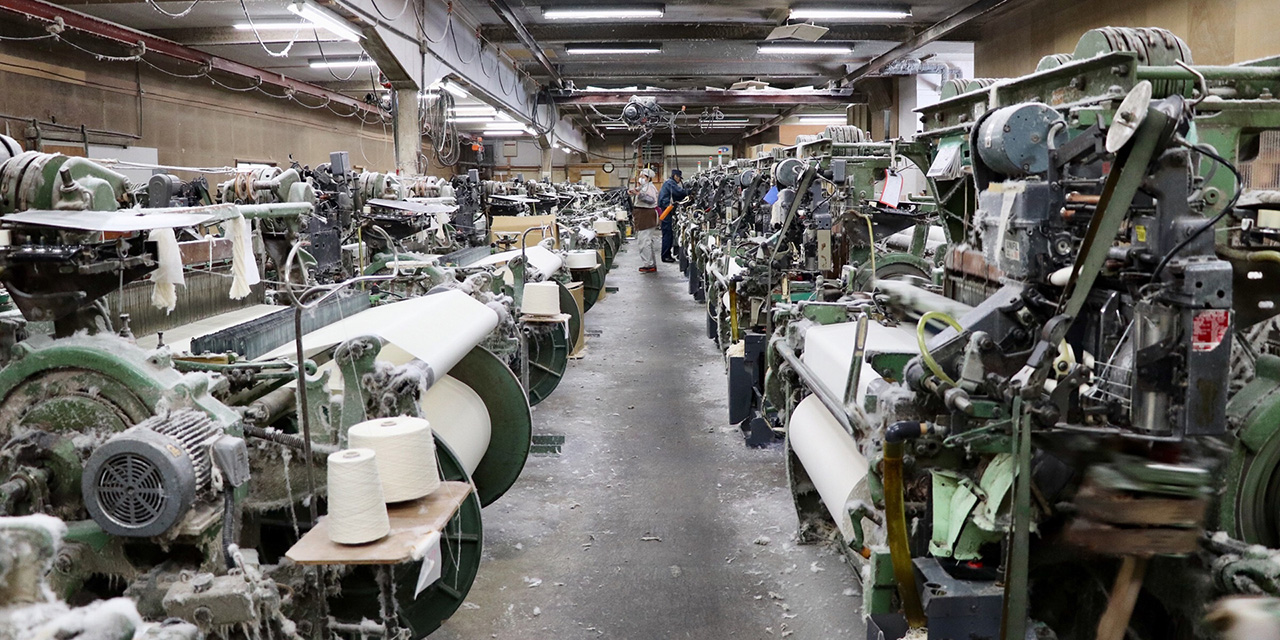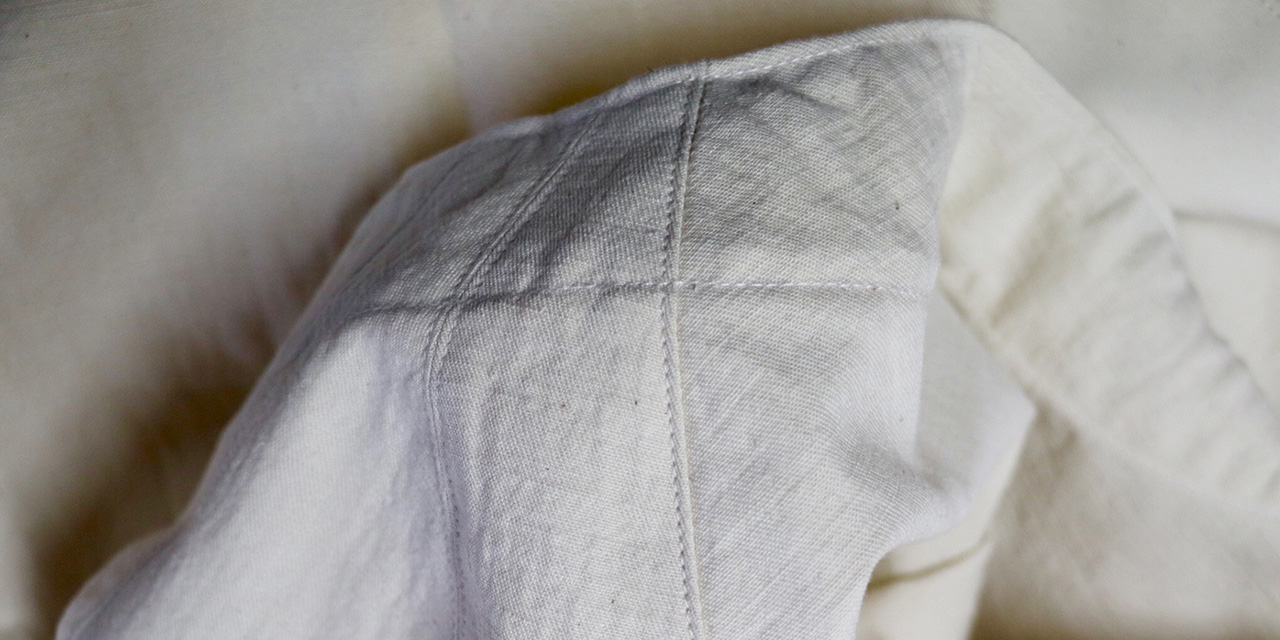ITTO UNSAI
壱等雲斎
服をつくることにおいて、理想とする素材や布を探すことは感動する服を作りだす為に必要な第一歩ともいえます。「タケヤリ」が生み出す、壱等雲斎(いっとううんさい)と備前壱号(びぜんいちごう)は、そんな私が惚れた生地の一つです。
「タケヤリ」とは国産帆布の製造で有名な、岡山県倉敷市にある老舗の機屋です。「タケヤリ」といえば帆布やカバンのイメージがありますが、衣類にも適した素晴らしい織物があり、その織物こそが、私達が探し求めていた織物でした。
About making clothing, looking for ideal material and fabric is the first step in the creation of impressive clothing. Itto UNSAI and Bizen Ichigo produced by TAKEYARI CO. are two fabrics I fell in love with.
TAKEYARI is an old-established weaver in Kurashiki, Okayama. The company is known for canvas and bag materials, but it also manufactures wonderful fabric suitable for clothing. And this is the one I had long searched for.

「タケヤリ」の歴史
The history of TAKEYARI
1888年岡山倉敷市児島地区の郷内にて、農業や行商をしていた武鑓石五郎と機織の名手である梅との結婚を機に製造業がはじまり、タケヤリの歴史がはじまりました。近所でも評判の織り手であった梅の元には評判を聞きつけた木綿問屋から角帯や足袋の底地など注文が入るようになりました。1958年には現在地(倉敷市曽原)に「武鑓織布工場」を設立。
Production began following the marriage of Ishigoro Takeyari, a farmer and trader in the Kojima region, and Ume, an accomplished weaver, and this marked the beginning of Takeyari’s history. Ume, who was known locally as an excellent weaver, began to receive orders for kakuobi(stiff sashes for men) and soles for tabi (a type of Japanese sock)from cotton merchants that had heard of her requtation. The “TAKEYARI Textile Factory” was established at its current location.
3代目和夫が導入したベルギー製シャトル機ピカノールは、他社では織ることのできない極厚の1~3号の帆布を生み出すことができ、1989年社名を武鑓織布株式会社から、株式会社タケヤリへ。現在では、タケヤリの機屋としての特徴を活かした自社ブランドも展開しています。
The “TAKEYARI Textile Factory” was established at its current location. Kazuo, the third generation , introduced picanol shuttle looms made in Belgium, and this allowed the company to produce extra-thick No.1~3 canvas, which other factories were unable to weave. The Company name changed from TAKETARI Textile Co.Ltd. to TAKEYARI Co.,Ltd. Currently, the company is developing three personal brands that make use of TAKEYARI’s characteristics as a weaver: “TAKEYARI since 1888,” “UNDER CANVAS” and “ITTO UNSAI.”

「タケヤリ」の帆布
What is canvas of “TAKEYARI”
岡山県倉敷市は全国の帆布生産シェア約70%という帆布の一大産地です。中世から江戸時代にかけて綿花の栽培が盛んだったことから繊維業、紡績業が発達しました。
帆布(はんぷ)とは無染の綿や麻の糸を撚り、平織りにした布の事です。英語ではCANVAS(キャンバス)と呼ばれています。目が詰まっていて丈夫、水漏れしないのに通気性に優れている事で古くから船の帆や馬具、学生カバンなどに使われてきました。タケヤリでは1~11号のすべての帆布製造を手掛けています。現存台数の少ないベルギー製のシャトル織機ピカノールを使い、ゆっくりと時間をかけて織り上げる事で風合いの良い帆布が生まれます。中でも1~3号の帆布は他では織ることの難しい極厚の帆布です。太い糸を密度を入れて織り上げる為、通常の帆布よりも固くしっかりとしています。
Kurashiki City in Okayama Prefecture is a major production area for canvas, and the area occupies 70% of the entire domestic canvas production share. The textile and cotton spinning industries developed in the area due to the popularity of cultivating cotton here from the medieval up to the Edo period. Canvas is a type of fabric made by twisting together of cotton and hemp, which is then woven in a plain weave. As canvas weaves are very tight, the fabric is durable and water-resistant while still retaining excellent breathability. Due to these qualities, the fabric has long been used for ship sails, horse riding gear, school bags, etc. TAKETARI manufactures all grades of canvas from No.1 to No.11. Slowly weaving the fabric over a long period of time using picanol shuttle looms made in Belgium, few of which are still in existence, results in fine-textured canvas. In particular, No.1~3 canvas possess a thickness that would be difficult to achieve elsewhere. The canvas is tougher and firmer than regular canvas as it created by densely weaving together thick strands.
そして、これらの経験を活かして帆布とは違う織物も生み出しています。
TAKEYARI creates fabric other than canvas making use of their experience.

壱等雲斎
Itto UNSAI
雲斎織は江戸時代頃、岡山県の備前地区で生まれ、地下足袋の底時などに使用され職人の足元を守ってきました。大量生産と効率主義の波に押され、徐々に忘れ去られてしまった、雲斎織を壱等雲斎として現代に甦らせました。現存台数の少ないベルギー製シャトル織機ピカノールを使い、ゆっくり時間をかけ、通常では考えられない程、限界まで密度(打ち込み本数)を入れ織り上げる事で、風合いの良い豊かな表情を生み出します。タテとヨコとも単糸×単糸(紡績したままの1本)による織物。
UNSAI weaving originated in the Bizen area of Okayama, and the fabric was used for Jika-tabi (outdoor footwear) soles to protect the feet of workers. Pushed by mass and efficiency-focused productions, UNSAI weaving was slowly forgotten. This UNSAI weaving has been rediscovered in the modern era as Itto UNSAI. Using the Belgian shuttle loom, PICANOL, which has become a rare machine, abundant time is spentto make an outstanding fabric with rich texture and appearance by unimaginably repeating the weaving until the limit of its density. Textile with single warp and weft threads (single spinned thread).

備前壱号
BizenIchigo
昭和30年代、戦後備前地域で学生服の使用と言う目的で開発された織物です。当時は物資が極端に不足しており、岡山県内の糸屋、機屋(織物)、染工場、学生服業者が、「子供たちの為に品格があり、洗濯にも強い丈夫で美しい生地」を生み出そうと、全ての知恵と情熱を出し合い、みんなで作り上げた織物です。タテとヨコとも双糸(2本の糸を撚り合わせた糸)による織物。タテ糸にコーマ糸(短い繊維を除き、長い繊維だけを平行にそろえた細番手の高級綿糸)を使用し織面は艶やなか光沢感と初めて感じる柔らかい肌触りを生み出します。
This fabric was developed sometime between 1955 and 1965, after WWII, in the Bizen area to be used for making school uniform. It was created in cooperation of yarn makers, textile makers, dye factories and school uniform makers in Okayama getting together to produce “beautiful fabric for children that has class and that can stand repeated washing,” and bringing out all their wisdom and passion, when, at the time, there was a stark lack of resources. Textiles created with twisted double threads used for warp and weft. Combed yarn (high-grade fine-count cotton thread made by removing short fibers and arranging only long fibers in parallel) is used for warp for glossy luster on the surface and a soft feel on the skin, a sensation that has never been experienced with other fabric.
COTTLEでは壱等雲斎をベースにオリジナルファブリックとして、タテ糸に綿、ヨコ糸に亜麻(リネン)を打ち込んだキバタ織物を作りました。綿の持つ綿毛の柔らかさと亜麻(リネン)特有の自然本来のネップや節感を活かした素材は、シャトル織機ピカノールによって、芽吹いたばかりの植物を育てていく様に、筆を走らす画家のキャンバスの様に。私達の創作意欲を表すアイデンティティになっています。(キバタとは染加工する前の生地)
COTTLE uses Itto UNSAI as base to create Kibata (gray fabric) with cotton for warp and linen for weft as an original fabric. Fabric is made using the softness of cotton and the natural nep of linen. This has become a representation of our identity that expresses our creative urge with the PICANOL shuttle loom, like growing a plant that has just sprouted or the canvas for an artist at work. (Kibata is a fabric before dyeing)
岡山県倉敷市は戦後から足袋の製造から始まり、作業服、学生服の産地として栄え、日本のデニムジーンズ発祥の地として有名な場所です、1960年頃から倉敷市児島ではデニムジーンズの製造が盛んに行われてきました。ジーンズの発祥はアメリカの作業者のワードローブとして生まれ、インディゴ色は生地に丈夫さや潤いを与え、ポケット口の補強を兼ねた金属のリベットなどが開発されてきました。
After WWII, prosperity of Kurashiki, Okayama began as the production center for tabi socks, which is followed by the production of work clothes and school uniforms, and the city is well known as the birthplace of Japanese denim jeans. From about 1960, the Kojima area in Kurashiki City flourished through the production of denim jeans. Jeans originated as clothing for workers in the US. Indigo color added durability and richness to the fabric and metal rivets for reinforcing the pocket opening and others have been developed.
デニムジーンズはアメリカから日本に渡ったものですが、私は「タケヤリ」の織物にも同じシンパシーを感じます。備前壱号や壱等雲斎が生まれた歴史の中には、純国産の帆布を織り続けきた長い歴史があり、沢山の職人達の経験と、つかい手の事を考えて改良していく、探求心と向上心があります。デニムジーンズと同じように織物としての丈夫さや、使い続けることでの風合い、肌にふれていく事での着心地において、きっとあなたを魅了する美しさがあると思うのです。
Denim jeans came to Japan from the US. And I feel the same empathy in the fabric created by TAKEYARI. In the history of Bizen Ichigo and Itto UNSAI, there exists a long tradition of weaving domestic canvas fabric, and experience, pursuit and ambition of many craftsmen who sought to make improvements considering the people who wear them. As with denim jeans, the beauty of our fabric will capture you with its durability and texture that becomes better as time passes and produces a comfortable feel on the skin.
つくり手のモノつくりへの思いや、産地の環境や歴史を、モノに託して伝え、次世代の人達にも受け継がれる思想を私達は目指しています。
We aim to hand down the philosophy to the people of next generation by communicating passion of creators for manufacturing, and the environment and history of the production area through the products we create.

> ITTO INSAI [linen44% – cotton56%]
Published at: 2021-06-17


